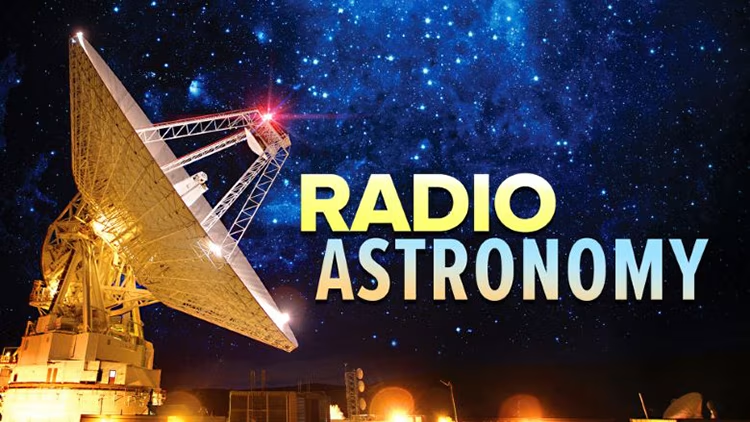Radio Astronomy: Observing the Invisible Universe Video

- 22h 13m Duration
- 31 Lectures
- 1775 Views
Radio Astronomy: Observing the Invisible Universe Video
It’s easy to imagine the first modern humans staring up at the heavens in wonder, their eyes and minds dazzled by a beautiful band of light splashed across the night sky, the ever-changing moon so large and bright, and pinpoints of light in every direction. For a few hundred thousand years, our eyes were our primary astronomical tool, and we used them well. We cataloged and analyzed what we saw, filled in the gaps with powerful stories, applied what we knew of mathematics, and then invented complex tools of stone, metal, and glass to expand our knowledge. Everything we knew about the universe was based on light, that small part of the electromagnetic spectrum detectable by human eyes.
Then one day in the 1930s, a young engineer named Karl Jansky was assigned a task at Bell Labs: What were the sources of radio static that could interrupt transatlantic radio communications? After several years of work, he identified one source as radio waves coming from thunderstorms near and far… and another, from something at the center of the Milky Way. For the very first time, we had detected radiation below the visible part of the spectrum emanating from an astronomical object. For years, astronomers had been frustrated by interstellar dust that blocked their view and limited their
Radio Astronomy: Observing the Invisible Universe takes you on a thrilling journey through the universe with stunning visuals and animations to explain the science of radio astronomy and its astounding discoveries. Your guide is Felix J. Lockman, Ph.D., of the Green Bank Observatory, an active radio astronomer whose great passion for his work is absolutely contagious. As Dr. Lockman explains, radio astronomy is not simply a conglomeration of theories with no practical application to our lives today. While radio astronomy has the potential to one day answer the question of extraterrestrial intelligence, it also allows us to more accurately tell time right here on Earth, study terrestrial plate tectonics, and even get smartphone directions to that great new restaurant.
All about That Hydrogen
Some of radio astronomy’s myriad discoveries can be traced to the structure of the hydrogen atom. In hydrogen, one electron is essentially in orbit around one proton and both have a property called “spin,” either up or down. The parallel spin “wants” to decay into antiparallel spin—much like two magnets “wanting” to be aligned north to south, or antiparallel. In jumping position from parallel to antiparallel, a photon of radiation is emitted.
This process is certainly not unique to hydrogen. What is unique is that at the dawn of radio astronomy, a scientist predicted hydrogen would emit this radiation at detectable radio wavelengths, and this prediction offered astronomers a new tool for studying the universe. Three teams of scientists from around the world worked to discover the signal, and there it was, exactly as predicted: with a frequency of 1420 MHz, a wavelength of 21 cm.
For more than a decade, hydrogen at 21 cm wavelength remained the only spectral line which radio astronomers could use for their research. Later, signals from other elements and even molecules were identified. Over time, as both theory and technology improved, radio astronomers made discoveries that completely changed our understanding of the universe. Just a very few of these discoveries include:
- Jupiter’s radiation belts;
- Galactic non-thermal radiation, now called synchrotron emission;
- The birth rate of stars in the Milky Way and the galaxy’s rotational speed;
- Sagittarius A, the black hole at the center of the Milky Way;
- Dark matter;
- Neutron stars, pulsars, and binary pulsar systems;
- Gravitational radiation, as predicted by Einstein;
- Cosmic background radiation, confirming the big bang theory;
- Radio galaxies, quasars, and active galactic nuclei;
- Giant molecular clouds, the birthplaces of stars and planets; and
- Complex organic molecules in interstellar space.
Radio Telescopes, “Seeing” the Invisible
While you might have an optical telescope in your backyard, you will likely never have a radio telescope. Radio telescopes are large—over 100 meters in diameter and beyond—because radio waves contain such a small amount of energy. For example, the signal from your cell phone measured one kilometer away is five million billion times stronger than the radio signals received from a bright quasar! Although each radio telescope is designed for a specific use and often looks very different from others, they are all based on the same physical principles. Each collects, focuses, amplifies, and analyzes radio waves. In Radio Astronomy: Observing the Invisible Universe, Dr. Lockman takes you on an exciting virtual tour of radio telescopes. From the first handmade telescope built by radio astronomy pioneer Grote Reber to those on the drawing board for tomorrow, you’re right there with the scientists:
- The Green Bank Telescope, West Virginia, where Dr. Lockman does his research. At 17 million pounds and with more than 2,000 surface panels that can be repositioned in real time, this telescope is one of the largest moveable, land-based objects ever built.
- The Very Large Array (VLA), New Mexico. With its 27 radio antennas in a Y-shaped configuration, the data can be multiplied to form interference patterns, giving scientists a deeper and clearer look at galaxies than ever before.
- The Atacama Large Millimeter/submillimeter Array (ALMA), Chile. With an array of 66 radio antennas located high above much of the earth’s atmosphere, ALMA has revealed new stars and planetary systems in the making.
- The Very-Long-Baseline Array (VLBA), with multiple locations. The VLBA includes telescopes located thousands of miles apart, all functioning together as one single radio telescope the size of the Earth, allowing scientists to peer deep into the centers of galaxies.
Total Size: 11.0 GB
Course Download Links
Download Instructions:
If Download link not loading or working then try with VPN.
Downoad all the parts then extract all zip files into 1 folder.
File Password: nulledsourcecode.com
-
Radio Astronomy: Observing the Invisible Universe Video - Download Part 1
DISCLAIMER
This course was obtained from a free source and is not hosted on the nulledsourcecode.com website. We can safely say that it is not our responsibility. Use this file whatever you like for your own purposes. Downloading copyrighted material is illegal, and all the files here are only for educational uses. Developers/creator/maker made it with difficulty. We request you to buy a genuine version from it creator/developer/owner's website.






![Become an Android Developer Nanodegree for free [2023]](https://nulledsourcecode.com/public/images/courses/64fd9da2715a4218_course.avif)